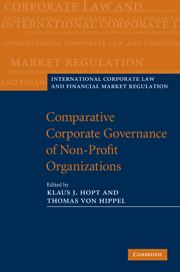Book contents
- Frontmatter
- Contents
- List of contributors
- Preface
- Abbreviations
- PART I Economic findings and theories on nonprofit organizations
- PART II The nonprofit sector: private law, trust law, tax law in selected countries
- PART III The board of nonprofit organizations
- PART IV Good governance of nonprofit organizations: activities and regulatory problems
- 10 Fundraising
- 10.1 The regulation of fund-raising by charities and voluntary organisations in England and Wales
- 10.2 Comparing regulation of fundraising: self-regulation or governmental regulation?
- 11 Asset management in nonprofit organizations
- 12 Nonprofit organizations and economic activities/enterprises
- PART V Good governance of nonprofit organizations: self-regulation, disclosure and supervision
- Index
- References
10.2 - Comparing regulation of fundraising: self-regulation or governmental regulation?
from 10 - Fundraising
Published online by Cambridge University Press: 05 August 2011
- Frontmatter
- Contents
- List of contributors
- Preface
- Abbreviations
- PART I Economic findings and theories on nonprofit organizations
- PART II The nonprofit sector: private law, trust law, tax law in selected countries
- PART III The board of nonprofit organizations
- PART IV Good governance of nonprofit organizations: activities and regulatory problems
- 10 Fundraising
- 10.1 The regulation of fund-raising by charities and voluntary organisations in England and Wales
- 10.2 Comparing regulation of fundraising: self-regulation or governmental regulation?
- 11 Asset management in nonprofit organizations
- 12 Nonprofit organizations and economic activities/enterprises
- PART V Good governance of nonprofit organizations: self-regulation, disclosure and supervision
- Index
- References
Summary
Introduction
Fundraising is a phenomenon that is closely connected to the non profit sector. This is illustrated by the fact that the term ‘fundraising’ is usually associated with raising of funds or goods for non profit organisations with a charitable, benevolent or other good cause. This is also the meaning of the term fundraising in this contribution. Herein I restrict myself to the raising of funds from the public. Income generated by means of sponsoring agreements, grants, fees for services and subsidies, fall outside the scope of this contribution.
Fundraising is an important source of income for the non profit sector. It can also be viewed as an activity that serves to inform the public about certain needs in society and to encourage the public ‘to do good’ by making donations for such purpose. These aspects of fundraising may explain to a certain extent why the overall amount generated by means of fundraising attracts considerable attention and is perceived, and sometimes presented, as a measure of the success of the non profit sector. This seems justified to me in the sense that this amount reflects the potential of the non profit sector to contribute to the community at large and, perhaps more importantly, that it reflects the measure of trust the community holds in the non profit sector. This trust is key in respect of fundraising.
- Type
- Chapter
- Information
- Comparative Corporate Governance of Non-Profit Organizations , pp. 662 - 698Publisher: Cambridge University PressPrint publication year: 2010



